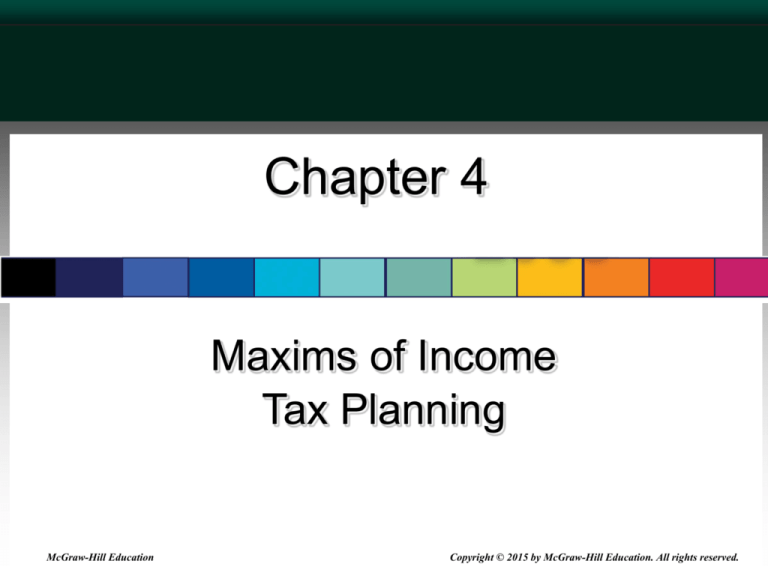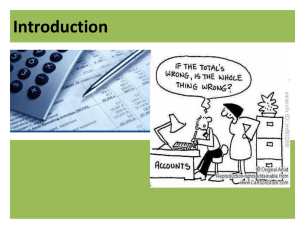
Chapter 4
Maxims of Income
Tax Planning
McGraw-Hill Education
Copyright © 2015 by McGraw-Hill Education. All rights reserved.
4-2
Objectives
• Differentiate between tax avoidance and tax evasion
• List the four variables that determine the tax consequences
of a transaction
• Explain why an income shift or a deduction shift can improve
NPV
• Explain how the assignment of income doctrine constrains
income-shifting strategies
• Distinguish between an explicit tax and an implicit tax
4-3
Objectives (continued)
• Contrast the tax character of ordinary income and capital
gain
• Distinguish between an explicit and implicit tax
• Summarize the four tax planning maxims
• Describe the legal doctrines that the IRS uses to challenge
tax planning strategies
4-4
Tax Avoidance
• Tax avoidance consists of legitimate means of
reducing taxes
• Tax evasion consists of illegal means of reducing
taxes
• Felony offense punishable by severe monetary fines
and imprisonment
4-5
Tax Planning Variables
• Tax consequences of a transaction depend on the
interaction of four variables
• Entity variable: Which entity undertakes the transaction?
• Time period variable: In which tax year does the
transaction occur?
• Jurisdiction variable: In which taxing jurisdiction does
the transaction occur?
• Character variable: What is the tax character of the
income, gain, loss, or deduction from the transaction?
4-6
Income Tax Planning - Entity
• Generally, taxable income is computed under the
same rules across business entities
• However, the tax on business income depends on the
difference in tax rates across entities
• The two taxpaying business entities are individuals
and corporations
4-7
Income Tax Planning - Entity
• Individual taxpayers
• Progressive tax rate structure
ranging from 10% to 39.6%
• Corporate taxpayers
• Progressive tax rate structure
ranging from 15% to 39%
• Both sets of rate schedules are included
in Appendix C
4-8
Tax Rates
• Compute 2014 tax, marginal rate, and average
rate on $250,000 income if:
• Taxpayer is a single individual
• Taxpayer is a corporation
• Answer:
• $66,358 ($45,354 + .33 [$250,000 – $186,350])
33% marginal rate; 26.54% average rate
• $80,750 ($22,250 + .39 [$250,000 – $100,000])
39% marginal rate; 32.3% average rate
4-9
Income Tax Planning – Entity Variable
• Tax costs decrease (and cash flows increase) when
income is generated by an entity subject to a low
tax rate
• When establishing a new business, consider the tax
rates paid by type of business entity
• See Chapter 12: passthrough entity versus corporation
4-10
Income Tax Planning – Entity Variable
• Income shifting
• Arranging transactions to transfer income from a high
tax rate entity to a low tax rate entity
• Deduction shifting
• Arranging transactions to transfer deductions from a
low tax rate entity to a high tax rate entity
• After an income or deduction shift, the parties in
the aggregate are financially better off by the tax
savings from the transaction
4-11
Income Tax Planning – Entity Variable
• Assignment of income doctrine
• Constraint on income shifting
• Income must be taxed to the entity that earns it from
sale of goods or performance of services
• Income generated by capital must be taxed to the entity
that owns the capital
4-12
Income Tax Planning – Time Period Variable
• In present value terms, tax costs decrease (and
cash flows increase) when a tax cost is deferred
until a later taxable year
• Constrained by:
• Opportunity costs
• Tax rate increase
4-13
Income Tax Planning – Time Period Variable
• Opportunity costs
• Shifting tax costs to later period may involve postponing
a cash inflow. Thus, the opportunity cost of postponing
the cash inflow may exceed the savings from tax
deferral
• Opportunity cost is the loss of the immediate
use of cash
4-14
Income Tax Planning – Time Period Variable
• Tax rate increase
• If taxpayers defer the recognition of income to a future
year and Congress increases future tax rates, the cost of
the rate increase offsets the benefit of the deferral
• The risk that deferred income will be taxed at a higher rate
increases with the length of the deferral period
4-15
Income Tax Planning - Opportunity Costs
• Assume that a taxpayer has a 30% tax rate and uses a
10% discount rate. Compute NPV of the following:
• Taxpayer receives $100 cash/income and pays tax now
• NPV = $70
• Taxpayer defers the receipt of cash/income by one year
• NPV = $64 ($70 × 0.909)
• Taxpayer receives $100 cash but defers recognizing
income by one year
• NPV = $73 ($100 – $27[$30 × 0.909])
4-16
Income Tax Planning - Tax Rate Increase
• Taxpayer receives $100 cash but defers
recognizing income by one year. Congress
increases the tax rate from 30% to 40% next year
• NPV = $64 ($100 – $36 [$40 × 0.909])
4-17
Income Tax Planning – Jurisdiction Variable
• The jurisdiction variable is important because local,
state, and foreign tax laws differ
• Tax costs decrease (and cash flows increase) when
income is generated in a low tax rate jurisdiction
• The jurisdiction variable is discussed in Chapter 13
4-18
Income Tax Planning – Character Variable
• Tax character of income is determined by law
• Every income item is characterized as either
ordinary income or capital gain
• Ordinary income is generated from sale of goods or
performance of services in regular course of business
• Income generated by investments (interest, dividends,
royalties, and rents) is ordinary
• Capital gains are generated by the sale or exchange of
capital assets (defined in Chapter 8)
4-19
Income Tax Planning – Character Variable
• Most types of ordinary income are taxed at regular
rates
• Exceptions include interest on state and local bonds (taxexempt) and qualified dividends (taxed at preferential
rates for individuals)
• Capital gains
• Taxed at preferential rates for individuals
• Taxed at regular rates for corporations
4-20
Income Tax Planning – Character Variable
• Tax costs decrease (and cash flows increase) when
income is taxed at a preferential rate because of its
character.
• Because capital gains are taxed at preferential rates,
individuals try to arrange transactions to convert ordinary
income to capital gain
• The Internal Revenue Code contains dozens of provisions
that prevent the conversion of ordinary income to capital
income
4-21
Conflicting Tax Planning Maxims
• Sometimes, the four tax planning maxims conflict!
• For example, a transaction defers tax may shift income
to an entity with a higher tax rate
• Managers should remember that their strategic goal
is not tax minimization but NPV maximization
4-22
Implicit Taxes
• Reduced before-tax rate of return on a tax-favored
investment is called an implicit tax
• Example: A corporate bond pays 9% and a municipal
bond pays 6.3%
• Investor who purchases the municipal bond incurs a 30% implicit
tax (2.7% reduced rate/9%)
• Investors with marginal rates greater than 30% maximize their
after-tax rate of return by purchasing the municipal bond
• Investors with marginal rates less than 30% maximize their aftertax rate of return by purchasing the corporate bond
4-23
Tax Law Doctrines
• IRS can use legal doctrines
to challenge a tax planning strategy
• Economic substance/business purpose doctrine A
transaction must have a business purpose other than
tax avoidance
• Codified in §7701(o)
• Substance over form doctrine IRS can look through legal
formalities to determine economic substance
• Step transaction doctrine IRS can collapse a series of
interdependent transactions into one transaction
4-24







